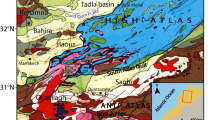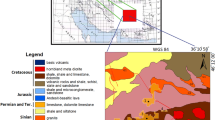Abstract
Concepts of fractal/multifractal dimensions and fractal measure were used to derive the prior and posterior probabilities that a small unit cell on a geological map contains one or more mineral deposits. This has led to a new version of the weights of evidence technique which is proposed for integrating spatial datasets that exhibit nonfractal and fractal patterns to predict mineral potential. The method is demonstrated with a case study of gold mineral potential estimation in the Iskut River area, northwestern British Columbia. Several geological, geophysical, and geochemical patterns (Paleozoic-Mesozoic sedimentary and volcanic clastic rocks; buffer zones around the contacts between sedimentary rocks and Mesozoic intrusive rocks; a linear magnetic anomaly; and geochemical anomalies for Au and associated elements in stream sediments) were integrated with the gold mineral occurrences which have fractal and multifractal properties with a box-counting dimension of 1.335±0.077 and cluster dimension of 1.219±0.037.
Similar content being viewed by others
References
Agterberg, F. P., 1989, computer programs for mineral exploration: Science, v. 245, p. 76–81.
Agterberg, F. P., 1992, Combining indicator patterns in weights of evidence modelling for resource evaluation: Nonrenewable Resources, v. 1, no. 1, p. 35–50.
Agterberg, F. P., 1994, Fortran program for the analysis of point patterns with correction of edge effects: Computers & Geosciences, v. 2, p. 229–245.
Agterberg, F. P., and Bonham-Carter, G. F., 1990, Deriving weights of evidence from geoscience contour maps for the prediction of discrete events,in Proceedings, 22nd APCOM Symposium held in Berlin, September 1990: Technical University Berlin, v. 2, p. 381–396.
Agterberg, F. P., Bonham-Carter, G. F., and Wright, D. F., 1990, Statistical pattern integration for mineral exploration, in Gaal, G., and Merriam, D. F., eds., Computer applications in resource exploration, prediction and assessment for metals and petroleum. Oxford, Pergamon Press, p. 1–21.
Agterberg, F. P., Cheng, Q., and Wright, D. F., 1993a, Fractal modelling of mineral deposits,in Elbrond J., and Tang, X., eds., Application of computers and operations research in the mineral industry, Proceedings, 24th APCOM Symposium, Montreal: Canadian Inst. Mining, Metallurgy and Petroleum Eng., v. 1, p. 43–53.
Agterberg, F. P., Bonham-Carter, G. F., Cheng, Q., and Wright, D. F., 1993b, Weights of evidence modelling and weighted logistic regression for mineral potential mapping:in Davis, J. C., and Herzfeld, U. C., eds., Computers in geology-25 years of progress, New Oxford University Press, p. 13–32.
An, P., Moon, W. M., and Rencz, A., 1991, Application of fuzzy set theory for integration of geological, geophysical, and remote sensing data:Canadian Journal of Exploration Geophysics, v. 27, p. 1–11.
An, P., Moon, W. M., and Bonham-Carter, G. F., 1992, On a knowledge-based approach of integrating remote-sensing, geophysical, and geological information:Proceedings IGARSS'92, p. 34–38.
An, P., Moon, W. M., and Bonham-Carter, G. F., 1994a, Uncertainty management in integration of exploration data using belief function:Nonrenewable Resources, v. 3, no. 1, p. 60–71.
An, P., Moon, W. M., and Bonham-Carter, G. F., 1994b, An object-oriented knowledge representation structure for mineral potential estimation:Nonrenewable Resources, v. 3, no. 2, p. 132–145.
B. C. Minfile Map 104B, 1989, British Columbia Ministry of Energy, Mines and Petroleum Resources.
Bishop, M. M., Fienberg, S. E., and Holland, P. W., 1975, Discrete multivariate analysis: theory and analysis: Cambridge, MA, MIT Press, 587 p.
Bonham-Carter, G. F., 1994, Geographic information system for geoscientists: modelling with GIS: Oxford, Pergamon, 398 p.
Bonham-Carter, G. F., and Chung, C. F., 1983, Integration of mineral resource data for Kasmere Lake area, northwestern Manitoba, with emphasis on uranium:Computers & Geosciences, v. 15, p. 25–45.
Bonham-Carter, G. F., and Wright, D. F., 1989, Weights of evidence modelling: a new approach to mapping mineral potential,in Agterberg, F. P., and Bonham-Carter, G. F., eds., Statistical applications in the Earth sciences: Geological Survey of Canada Paper 89-9, p. 171–183.
Bonham-Carter, G. F., Agterberg, F. P., and Wright, D. F., 1988, Integration of geological datasets for gold exploration in Nova Scotia:Photogrammetry and Remote Sensing, v. 54, no. 11, p. 1585–1592.
Carlson, C. A., 1991, Spatial distribution of ore deposits:Geology, v. 19, February, p. 111–114.
Cheng, Q., 1985, Comprehensive information quantitative appraisal of gold mineral resources in north China Platform:unpublished MSc thesis, Changchun University of Earth Sciences (in Chinese with English abstract), 200 p.
Cheng, Q., 1986, A fuzzy integral model for quantitative mineral resource appraisal,in Wang, S., ed. &Journal of Changchun University of Earth Sciences, special issue (in Chinese with English abstract), p. 35–41.
Cheng, Q., 1989, Multiple population mineral resources simulating method,in Wang, S., Fan, J., and Cheng, Q., eds.Journal of Changchun University of Earth Sciences, special issue (in Chinese with English abstract), p. 50–59.
Cheng, Q., 1995, Discussion of the perimeter-area fractal model and its application in geology.Mathematical Geology, v. 27, no. 1, p. 69–82.
Cheng, Q., 1996, Discrete multifractals: Mathematical Geology, in preparation.
Cheng, Q., and Agterberg, F. P., 1995, Multifractal modelling and spatial point processes: Mathematical Geology, v. 27, no. 7, p. 1–16.
Cheng, Q., and Agterberg, F. P., 1996, Multifractal modelling and spatial statistics: Mathematical Geology, v. 28, no. 1, p. 1–16.
Cheng, Q., and Wang, S., 1990, Comprehensive information mineral resource appraisal: theory and method:Proceedings 22nd APCOM, Technical University of Berlin, v. 2, September, p. 397–410.
Cheng, Q., and Agterberg, F. P., 1996, Comparison of two multifractal models: Mathematical Geology, submitted.
Cheng, Q., Agterberg, F. P., and Ballantyne, S. B., 1994a, The separation of geochemical anomalies from background by fractal methods:Geochemical Exploration, v. 51, no. 2, p. 109–130.
Cheng, Q., Agterberg, F. P., and Bonham-Carter, G. F., 1994b, Fractal pattern integration for mineral potential mapping:Proceedings IAMG'94, Mont-Tremblant, Quebec, October, p. 74–80.
Cheng, Q., Agterberg, F. P., Bonham-Carter, G. F., and Sun, J., 1994c, An artificial intelligence model for integrating spatial patterns for mineral potential estimation with incomplete information:Proceedings of the 6th Canadian Conference on Geographic Information Systems, Ottawa, Ontario, v. 1, June 4–10, p. 261–274.
Cheng, Q., Bonham-Carter, G. F., Agterberg, F. P., and Wright, D. F., 1994d, Fractal modelling in the geosciences and implementation with GIS,Proceedings of the 6th Canadian Conference on Geographic Information Systems, Ottawa, Ontario, v. 1, June 4–10, p. 565–577.
Cheng, Q., Agterberg, F. P., and Bonham-Carter, G. F., 1995d, A spatial analysis method for geochemical anomaly recognition,in Mitri, H. S., ed., Proceedings of CAMT'95 Computer Applications in the Mineral Industry, Montreal, Canada, October 22–25, p. 27–36.
Chung, C. F., and Fabbri, A. G., 1993, The representation of geoscience information for data integration:Nonrenewable Resources, v. 2, no. 2, p. 122–139.
Chung, C. F., and Moon, W. M., 1991, Combination rules of spatial geoscience data for mineral exploration:Geoinformatics, v. 2, no. 2, p. 159–169.
Coleman, P. H., and Pietronero, L., 1992, The fractal structure of the universe:Physical Reports (Review Section of Physical Letters), v. 213, no. 6, p. 311–389.
Cressie, N. A. C., 1991, Statistics for spatial data: New York, Wiley, 900 p.
Diggle, P. J., 1983, Statistical analysis of spatial point patterns: London, Acadmeic Press, 148 p.
Evertsz, C. J. G., and Mandelbrot, B. B., 1992, Multifractal measures, Appendix B,in Peitgen, H.-O., Jürgens, H., and Saupe, D., eds.,Chaos and fractals: New York, Springer Verlag, p. 922–953.
Feder, J., 1988,Fractals: New York, Plenum, 283 p.
Geological Survey of Canada, 1978, Aeromagnetic and gravity data of 104B map sheet: Geophysical Data Centre, Geophysical Division, Geological Survey of Canada.
Geological Survey of Canada, 1988, National geochemical reconnaissance 1∶250,000 map sheet, Iskut River, British Columbia (NTS 104B): GSC Open File 1645.
Harris, D. P., 1984,Mineral resources appraisal: Oxford, Clarendon Press, 445 p.
Harris, D. P., and Pan, G., 1991, Consistent geological areas for epithermal gold-silver deposits in the Walker Lake Quadrangle of Nevada and California: delineated by quantitative methods: Economic Geology, v. 86, p. 142–165.
Mandelbrot, B. B., 1983,The fractal geometry of nature. San Francisco, W. H. Freeman and Company; New York, updated and augmented edition, 468 p.
McCammon, R. B., Botbol, J. M., Sinding-Larsen, R., and Bowen, R. W., 1983, Characteristic analysis-1981: final program and a possible discovery: Mathematical Geology, v. 15, no. 1, p. 59–83.
Ripley, B. D., 1981, Spatial statistics: New York, Wiley, 252 p.
Ripley, B. D., 1988, Statistical inference for spatial processes: Cambridge, Cambridge University Press, 148 p.
Wang, S., Cheng, Q., and Fan, J., 1990, Methods for gold mineral resources appraisal: Jilin, P. R. China, Press of Jilin Sci. & Tech. (in Chinese), 441 p.
Wright, D. F., and Bonham-Carter, G. F., 1996, VMS facorability mapping with GIS-based interpretation models, Chisel-Anderson map area, Manitoba,in Bonham-Carter, G. F., Galley, A. G., and Hall, G. E. M., eds., EXTECH I: A multidisciplinary approach to massive sulphide deposits in the Rusly Lake—Snow Lake greenstone belts: Geological Survey of Canada, Bulletin, in press.
Author information
Authors and Affiliations
Rights and permissions
About this article
Cite this article
Cheng, Q., Agterberg, F.P. & Bonham-Carter, G.F. Fractal pattern integration for mineral potential estimation. Nat Resour Res 5, 117–130 (1996). https://doi.org/10.1007/BF02257585
Received:
Accepted:
Issue Date:
DOI: https://doi.org/10.1007/BF02257585




